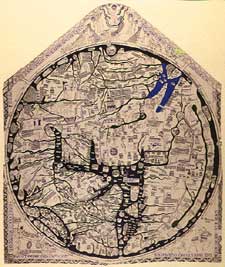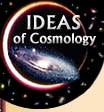| |

A
map of the world from England ca. 1300, with Jerusalem at the center.
Europe occupies the lower
left quadrant. |
"Of
what importance is it to know
whether the Earth is a sphere, a cylinder, a disk, or a concave surface?"
asked St. Basil in the fourth century. "What is important is to know
how I should conduct myself towards myself, towards my fellow man, and
towards God." With the decay of classic civilization in Western Europe,
few people cared about cosmology. Those who did, mostly kept to a simplified
version of the Greek speculations. Some used the authority of ambiguous
Biblical verses to revert to the primitive picture of a flat Earth. Perhaps
our world was a disk, centered on Jerusalem (which was a new idea, for
other nonscientific peoples had placed their own homeland at the center
of the Universe). When civilization and scientific curiosity revived in
the late Middle Ages, scholars seeking the ancient Greek writings in the
dusty archives of monasteries found that many had been erased by monks,
recycling the valuable parchment for pious works.
|


